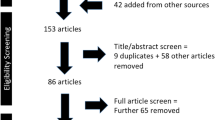Abstract
Chinese medicine (CM) is a discipline with its own distinct methodologies and philosophical principles. The main method of treatment in CM is to use herbal prescriptions. Typically, a number of herbs are combined to form a formula and different formulae are prescribed for different patients. Regularities in the mixture of herbs in the prescriptions are important for both clinical treatment and novel patent medicine development. In this study, we analyze CM formula data using latent tree (LT) models. Interesting regularities are discovered. Those regularities are of interest to students of CM as well as pharmaceutical companies that manufacture medicine using Chinese herbs.
Similar content being viewed by others
References
Anonymous. The Inner Canon of Emperor Huang. Beijing: Chinese Medical Ancient Books Publishing House; 2003.
Tang JL, Liu BY, Ma KW. Traditional Chinese medicine. Lancet 2008; 372:1938–1940.
Flaws B, Sionneau P. The treatment of modern western medical diseases with Chinese medicine: a textbook and clinical manual (2nd ed). Kansas: Blue Poppy Press; 2005.
Wan L, Zhou GB, Liu P, Song JH, Liang Y, Yan XJ, et al. Dissection of mechanisms of Chinese medicinal formula Realgar-Indigo naturalis as an effective treatment for promyelocytic leukemia. PNAS 2008;105:4826–4831.
Zhou X, Chen S, Liu BY, Zhang R, Wang Y, Lin P, et al. Development of traditional Chinese medicine clinical data warehouse for medical knowledge discovery and decision support. Artif Intell Med 2010;48:139–152.
Feng Y, Wu Z, Zhou X, Zhou Z, Fan W. Knowledge discovery in traditional Chinese medicine: state of the art and perspectives. Artif Intell Med 2006;38:219–236.
Zhang NL, Yuan SH, Chen T, Wang Y. Latent tree models and diagnosis in traditional Chinese medicine. Artif Intell Med 2008;42:229–245.
Zhang NL, Yuan SH, Chen T, Wang Y. Statistical validation of traditional Chinese medicine theories. J Altern Compl Med 2008;14:583–587.
Jakulin A, Bratko I. Testing the significance of attribute interactions. ICML 2004;69:409–416.
Schwarz G. Estimating the dimension of a model. Ann Statist 1978;6:461–464.
Zhang NL. Hierarchical latent class models for cluster analysis. J Mach Learn Res 2004;5:697–723.
Zhang R. Clinical research on the syndrome structure and syndrome hierarchical differentiation of disharmony of liver and spleen syndrome [dissertation]. Guang’anmen hospital, China Academy of Chinese Medical Sciences; 2008:5.
Author information
Authors and Affiliations
Corresponding author
Additional information
Supported by Program of Beijing Municipal S&T Commission, China (No. D08050703020803, D08050703020804), China NSFC Project (No. 90709006), National Key Technology R&D Program k (2007BA110B06), and China 973 Project (No. 2011CB505101)
Rights and permissions
About this article
Cite this article
Chen, T., Zhou, Xz., Zhang, Rs. et al. Discovery of regularities in the use of herbs in chinese medicine prescriptions. Chin. J. Integr. Med. 18, 88–92 (2012). https://doi.org/10.1007/s11655-011-0860-6
Received:
Published:
Issue Date:
DOI: https://doi.org/10.1007/s11655-011-0860-6




